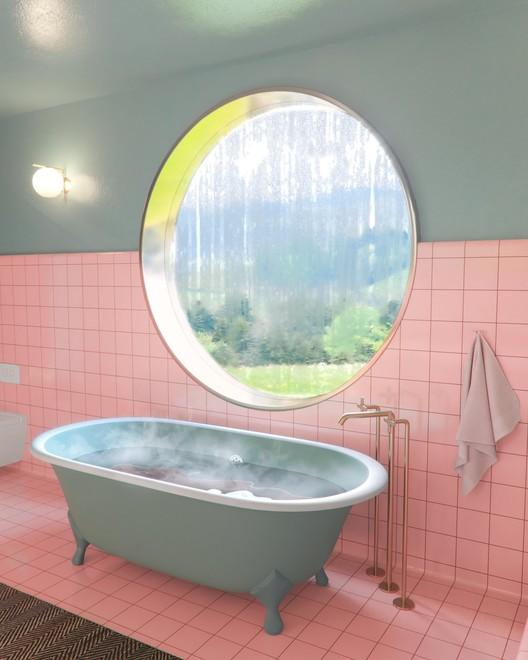Even though white minimalism remains the norm, retro trends are making a serious comeback in modern bathroom designs, with homeowners incorporating pops of color, classic fixtures, and patterned surfaces. Despite often being static and traditional spaces in homes, bathrooms have certainly undergone significant transformations throughout the years. While those of the outspoken 1970s brought vibrant colors like avocado green and mustard yellow, the ‘80s introduced ceramic tiles in more muted, pastel shades. On the other hand, this century has set the ideal on white and marbled surfaces, slick gloss finishes, and silver fixtures. However, even as this all-white look continues to be the protagonist, bold retro enhancements are reviving and blending in with contemporary elements to create elegant, yet lively atmospheres with a strong character.
Essentially, the term Retro in interior design refers to reviving trends from the 1950s to 1980s era by incorporating them into modern spaces – whether it be through color, accessories, furniture or geometric shapes and patterns. This does not mean, nonetheless, that designs have to be aged or outdated, but rather implies an eclectic mix of the old and new. In other words, embracing a modern look with a refreshed retro sentiment that transmits a certain nostalgia. Today, this modernized version of retro is popular among homeowners (especially millennials) that are attracted to a more unique and playful aesthetic that escapes the classic white canvas.
From classic fixtures to colorful patterned walls, many past design elements can be incorporated in bathrooms to achieve this contemporary retro style. Here, we present some trends that have made a comeback, along with the timeless materials used to achieve them.
Nothing screams retro quite like bold colors, whether it be in flooring, walls, sinks, toilets, or bathtubs. Lively pastel hues like dusty blue, mint, peach, and salmon all made their appearances throughout ‘80s bathrooms, providing a fun ambiance by combining seemingly incompatible tones. Even though this color scheme fell out of fashion in the ‘90s, it seems to be making a comeback. But, instead of being fully saturated spaces, modern bathrooms are mostly integrating some pops of color in the form of ceramic tiles.
Many modern houses encapsulate this aesthetic, such as a small granite home where pale green tiles clad the chimney-style shower. Likewise, House L&W has mainly all-white interiors, but includes a retro-inspired shower covered in mint ceramic tiles, a very popular bathroom shade in the ‘70s (even featured in iconic movies like The Shining).
Other examples include non-residential projects like Lavabo Tri Suave or these mixed bathrooms with no gender distinction. Both include pastel pink tiles (either in flooring or walls) that were huge in the ‘50s, resulting in comforting contemporary spaces with a retro feel.

Thanks to their versatility and timelessness, ceramic tiles have been used in bathrooms for decades. Apart from being durable, low-maintenance, and lightweight, these come in a wide array of colors, sizes, finishes, and patterns, offering high design flexibility for various layouts and applications. Thus, they can be customized according to the desired décor of the room, making this modernized retro style possible.
When it comes to bathroom fixtures, concepts like “vibrant” or “bold” don’t immediately come to mind. But, a growing trend of colorful sinks, tubs, and toilets with gold metallic accents will probably change that. Inspired by the ‘50s and '60s, tones like bubblegum pink and turquoise are coming back and being combined with modern, minimalistic forms.
For their part, chrome fixtures have long dominated in modern bathroom designs, leaving behind the gold polished brass from past decades. But, nowadays, vintage-inspired gold tones have re-emerged, whether it be in champagne bronze or brushed gold – and in natural, matt, or gloss finishes. The golden trend is present, for example, in faucets, showers, and accessories that, together with colorful ambiances, convey a retro feel with a modern twist.
With this in mind, manufacturers like British company Kast developed a new version of its traditional pigmented concrete sinks. Because of concrete’s high versatility and flexibility, these offer carved surfaces, highly defined textures, and bold colors that – especially when combined with gold elements – transmit a strong retro influence. Hence, just adding a few retro-inspired elements is enough to reflect the look.
Inspired by the pop art movement, interior design in the swinging ‘60s was characterized by expressive textures, geometric shapes, and saturated colors. Thus, it also saw an insurgence of heavily patterned walls with the use of tiles, terrazzo, and fun wallpapers.
Today, we are seeing a revival of these vibrant patterns in modern bathrooms, integrating unique shapes and retro color schemes. Such is the case of the bathroom suite in Fagerstrom House, where architects used green tiles for the floor and walls to create an immersive hexagonal pattern. Similarly, the renovated bathroom in House HC incorporates a geometric tile pattern with different shades of bright yellow.
Apart from ceramic tiles, terrazzo was huge in homes from the ‘50s and ‘60s until it fell out of fashion in the disco era. It didn’t take long, however, for it to revive in contemporary interior design, mainly due to its durability, design flexibility, and easy installation. While modern bathrooms like the one in House P integrate colorful terrazzo surfaces, others like in Cats’ Pink House use a playful wallpaper that imitates the retro look of the material.
Just like in fashion, design trends always come back; but to survive, they must be re-interpreted, refreshed, and combined with modern elements. Regarding bathrooms, the key lies in balancing retro trends with contemporary, minimalistic styles and configurations. Only this way can they be unique and vintage-inspired, yet still fitting for more updated buildings.